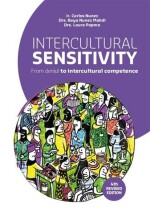Summary: Intercultural Sensitivity | 9789023255550 | Nunez, et al
- This + 400k other summaries
- A unique study and practice tool
- Never study anything twice again
- Get the grades you hope for
- 100% sure, 100% understanding
Read the summary and the most important questions on Intercultural sensitivity | 9789023255550 | Nunez, C.
-
1 Culture, Communication and Global Citizenship
This is a preview. There are 7 more flashcards available for chapter 1
Show more cards here -
1.1 What is Culture? Visible and Invisible Culture
This is a preview. There are 2 more flashcards available for chapter 1.1
Show more cards here -
What is Artifacts of culture?
This is the outer layer/ material culture.
These are the first things you notice when you enter a new country (ex, Netherlands the bicycles). If you would only define culture through artifacts, then you will get ‘stereotypes’.
"Dutch people eat bread and drink milk at lunchtime." -
What are norms and values?
Norms are the (un)written standards of correct, desired behavior (be on time in class). Values express what we think is good or right (is it good to stand up for the elderly on the bus?).
Norms and values are not as visible as artefacts. It takes some time to notice and even more to learn them.
They are unwritten and written standards to correct, desired behavior. -
1.2 Defintion of Culture
This is a preview. There are 1 more flashcards available for chapter 1.2
Show more cards here -
What is culture? Geert Hofstede
Culture is the collectiveprogramming of the mind, whichdistinguishes the members of one group (..) of people from another." -
What is culture? Edgar Schein
A pattern of shared basic assumptions that the group learned as it solved its problems of external adaptation and internal integration, that has worked well enough to be considered valid and therefore to be taught to new members as the correct way to perceive, think, and feel in relation to those problems." -
What is culture? Fons Trompenaars
Culture is the way in which a group of people solves problems." -
What is culture? Mijnd Huisjer
A group's set of shared norms and values expressed in the behavior of the group's members." -
1.3 Culture Programming
This is a preview. There are 1 more flashcards available for chapter 1.3
Show more cards here -
What is culture programming?
Culture is learned, Hofstede calls it programming. We are ‘programmed’ through upbringing, socialization, norms and values, and perception. Regardless of culture, each person is a unique individual and makes choices. -
1.6 Noise. What exaclty is communication Noise?
This is a preview. There are 4 more flashcards available for chapter 1.6
Show more cards here -
Intercultural communication - Noise
Communication is the exchange of meaning. If you want to give information to another person, you’re the source.
Your information is encoded by using the appropriate language or expressions.
The message can be distorted by noise, this can be external (the sound of an airplane that causes that you can hear the message) or internal (you are worried about something, so your attention is somewhere else). You can also have cultural noise (the volume of Dutch people can be too loud for Indonesians for speaking professionally). -
2 Working with Hall's Key Concepts of cultural differences
-
2.1.1 Low Context
This is a preview. There are 1 more flashcards available for chapter 2.1.1
Show more cards here -
What is Low Context?
In low context cultures, information is communicated explicitly, with words.
A low context culture has a preference for starting with the main point and ending with details. -
Low Context Definition & Countries
In low context cultures, information is communicated with words (written or spoken).
People prefer to structure their information into segments/ compartments. This is called compartmentalizing. Personal relations, work, and everything else you deal with are also compartmentalized. The information has a clear structure but is doesn’t flow fast, because it remains within the compartments.
A low-context culture has a preference for starting with the main point and ending with details.
Most people in the Netherlands communicate in a low context.- North-Western Europe,
- North America,
- Australia and
- New Zealand
- Higher grades + faster learning
- Never study anything twice
- 100% sure, 100% understanding

































